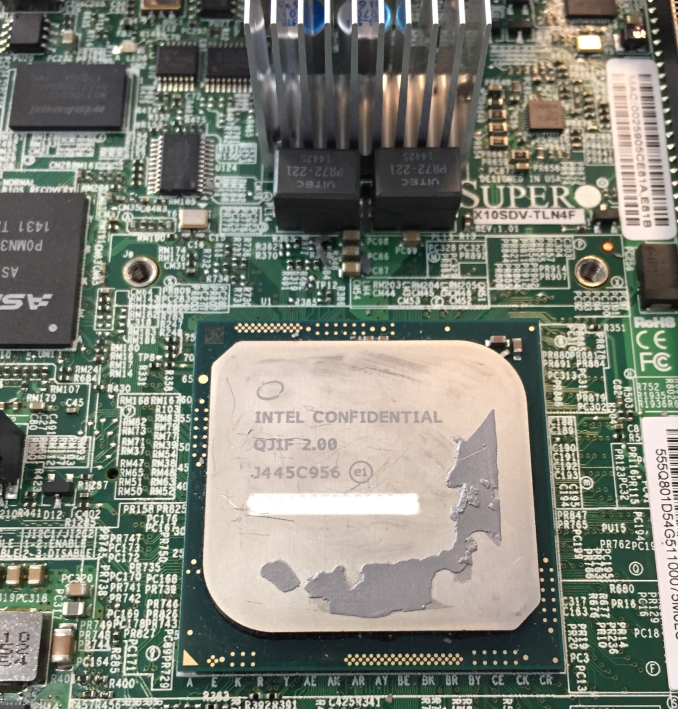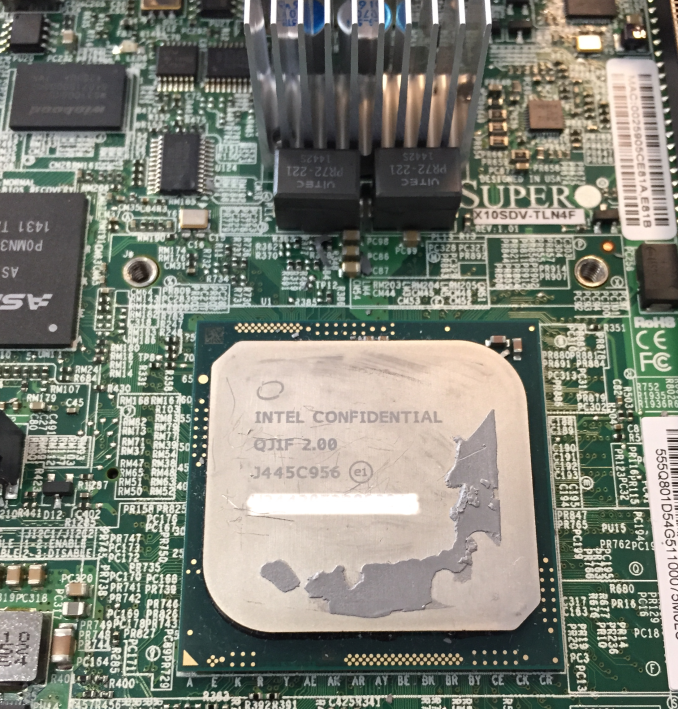The Intel Xeon D Review: Performance Per Watt Server SoC Champion?
by Johan De Gelas on June 23, 2015 8:35 AM EST- Posted in
- CPUs
- Intel
- Xeon-D
- Broadwell-DE

The days that Intel neglected the low end of the server market are over. The most affordable Xeon used to be the Xeon E3: a desktop CPU with a few server features enabled and with a lot of potential limitations unless you could afford the E5 Xeons. The gap, both in performance and price, between Xeon E3 and E5 is huge. For example - a Xeon E5 can address up to 768 GB and the Xeon E3 up to 32 GB. A Xeon E5 server could contain up to 36 cores, whereas Xeon E3 was limited to a paltry four. And the list is long: most RAS features, virtualization features were missing from the E3, along with a much smaller L3-cache. On those terms, the Xeon E3 simply did not feel very "pro".
Luckily, the customers in the ever expanding hyperscale market (Facebook, Amazon, Google, Rackspace and so on) need Xeons at a very large scale and have been demanding a better chip than the Xeon E3. Just a few months ago, the wait was over: Xeon D fills the gap between the Xeon E3 and the Xeon E5. Combining the most advanced 14 nm Broadwell cores, a dual 10 gigabit interface, a PCIe 3.0 root with 24 lanes, USB and SATA controllers in one integrated SoC, the Xeon D has excellent specs on paper for everyone who does not need the core count of the Xeon E5 servers, but who simply needs 'more' than the Xeon E3.
Many news editors could not resist calling the Xeon D a response to the ARM server threat. After all, ARM has repeated more than once that the ambition is to be competitive in the scale-out server market. The term "micro server" is hard to find on the power point slides these days; the "scale-out" market is a lot cooler, larger and more profitable. But the comments of the Facebook engineers can quickly brings us back to reality:
"Introducing "Yosemite": the first open source modular chassis for high-powered microservers"
"We started experimenting with SoCs about two years ago. At that time, the SoC products on the market were mostly lightweight, focusing on small cores and low power. Most of them were less than 30W. Our first approach was to pack up to 36 SoCs into a 2U enclosure, which could become up to 540 SoCs per rack. But that solution didn't work well because the single-thread performance was too low, resulting in higher latency for our web platform. Based on that experiment, we set our sights on higher-power processors while maintaining the modular SoC approach."
It is pretty simple: the whole "low power simple core" philosophy did not work very well in the real scale out (or "high powered micro server") market. And the reality is that the current SoCs with an ARM ISA do not deliver the necessary per core performance: they are still micro server SoCs, at best competing with the Atom C2750. So currently, there is no ARM SoC competition in the scale out market until something better hits the market for these big players.
Two questions remain: how much better is the 2 GHz Xeon D compared to the >3GHz Xeon E3? And is it an interesting alternative to those that do not need the high end Xeon E5?











90 Comments
View All Comments
zodiacfml - Tuesday, June 23, 2015 - link
this is the reason why Intel focuses on mobile, it benefits their server cpus too.the 14nm process is the one to thank for these massive improvements. Samsung also has 14nm and the S6 Exynos is in similar achievement
Refuge - Tuesday, June 23, 2015 - link
I disagree, the Exynos is no where close to a similar achievement.Granted it is doing better than Qualcomm's equivalent at the moment.
But I'm also faster than a fat man with a broken leg running on a hot and humid day.
zodiacfml - Tuesday, June 23, 2015 - link
Still, these 14nm SoCs are the best in their class as they pack more cores while using less power.LukaP - Thursday, June 25, 2015 - link
Just a note, Samsung's (and TSMC's 16nm FF(+) process isnt really 16nm entirely. The interconnects are still 28nm making it not nearly as dense as intel's 14nm, as well as being more leaky. IIRC their density and leakage can be compared to intels 22nm TriGate in the times of Ivy Bridgenils_ - Tuesday, June 23, 2015 - link
Few questions:1. Why did you disable x2apic?
2. Did the Large Page allocation in the Java Benchmark actually work? It can be a bit tricky some times and then falls back to 4KiB pages
3. What were the JVM settings for elasticsearch?
JohanAnandtech - Thursday, June 25, 2015 - link
1. Was out of the box disabled. I have to admit I did not check that option. Performance impact should be neglible though.2. I have no monitored that, but there was a performance impact if we disabled it.
3. ES_heap_size = 20 G; otherwise standard ES settings
Daniel Egger - Tuesday, June 23, 2015 - link
Wow, that is still quite pricey here. For the price of the SuperMicro tower you can actually get a 1U 2S Xeon E5 system with one socket equipped and some memory. I'd really love to replace my home server (running on Core i5 rather than Xeon E3 for efficiency reasons, those C chipset suck balls) with one of those systems if they can make them efficient and quiet.hifiaudio2 - Tuesday, June 23, 2015 - link
Two questions:1. How does the Xeon D compare to the c2700 series for a home NAS that will also serve as an Emby server and HDHR DVR (when that software is available). Could be one or two 1080p transcodes going on at the same time at most. Usually no transcoding if I am using Kodi or something that can natively play back the file, but for remote viewing or random uses over the network, some transcoding by Emby could be required -- if you are not familiar with Emby think of the same thing using Plex. So would the extra power of the Xeon D be of use to me, or is the 8 core c2750 plenty for the aforementioned use case?
2. If I do go with this unit, which dimms specifically does it use? The Supermicro c2750 board takes laptop style dimms. What does this take?
JohanAnandtech - Tuesday, June 23, 2015 - link
I can answer 2: see the picture here: http://www.anandtech.com/show/9185/intel-xeon-d-re... RDIMMs or UDIMMS (= basically "normal" DDR-4) will do.hifiaudio2 - Tuesday, June 23, 2015 - link
Thanks.. So this ram:?http://www.amazon.com/Crucial-PC4-2133-Registered-...
And what is the SR x4 / DR x8 difference in the two choices for the 8gb sticks?